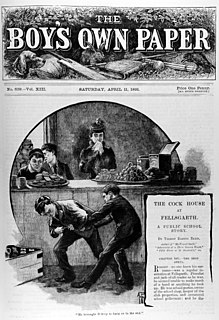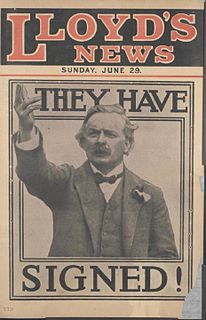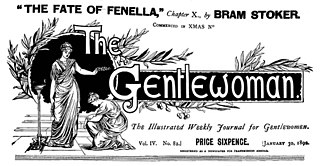
The Observer is a British newspaper published on Sundays. In the same place on the political spectrum as its sister papers The Guardian and The Guardian Weekly, whose parent company Guardian Media Group Limited acquired it in 1993, it takes a social liberal or social democratic line on most issues. First published in 1791, it is the world's oldest Sunday newspaper.

The Illustrated London News appeared first on Saturday 14 May 1842, as the world's first illustrated weekly news magazine. Founded by Herbert Ingram, it appeared weekly until 1971, then less frequently thereafter, and ceased publication in 2003. The company continues today as Illustrated London News Ltd, a publishing, content, and digital agency in London, which holds the publication and business archives of the magazine.

The Graphic was a British weekly illustrated newspaper, first published on 4 December 1869 by William Luson Thomas's company Illustrated Newspapers Ltd. Thomas's brother Lewis Samuel Thomas was a co-founder. The premature death of the latter in 1872 "as one of the founders of this newspaper, [and who] took an active interest in its management" left a marked gap in the early history of the publication. It was set up as a rival to the popular Illustrated London News.

The Daily Graphic: An Illustrated Evening Newspaper was the first American newspaper with daily illustrations. It was founded in New York City in 1873 by Canadian engravers George-Édouard Desbarats and William Leggo, and began publication in March of that year. It continued publication until September 23, 1889.

Herbert Ingram was a British journalist and politician. He is considered the father of pictorial journalism through his founding of The Illustrated London News, the first illustrated magazine. He was a Liberal politician who favoured social reform and represented Boston for four years until his early death in the shipwreck of the Lady Elgin.

The Sketch was a British illustrated weekly journal. It ran for 2,989 issues between 1 February 1893 and 17 June 1959. It was published by the Illustrated London News Company and was primarily a society magazine with regular features on royalty, aristocracy and high society, as well as theatre, cinema and the arts. It had a high photographic content with many studies of society ladies and their children as well as regular layouts of point to point racing meetings and similar events.

Black and White: A Weekly Illustrated Record and Review was a British Victorian-era illustrated weekly periodical founded in 1891 by Charles Norris Williamson. In 1912, it was incorporated with The Sphere.
Montague Dawson RSMA, FRSA (1895–1973) was a British painter who was renowned as a maritime artist. His most famous paintings depict sailing ships, usually clippers or warships of the 18th and 19th centuries.

Magazines intended for boys fall into one of three classifications. These are comics which tell the story by means of strip cartoons; story papers which have several short stories; and pulp magazines which have a single, but complete, novella in them. The latter were not for the younger child and were often detective or western in content and were generally greater in cost. Several titles were published monthly whereas the other two categories were more frequent.

Ernest Prater (1864–1950) was a noted English artist and book illustrator, notable also for his work as a war correspondent and reportage artist during the Anglo-Boer War.

The Illustrated Sporting and Dramatic News was a British weekly magazine founded in 1874 and published in London. In 1945 it changed its name to the Sport and Country, and in 1957 to the Farm and Country, before closing in 1970.

Lloyd's Weekly Newspaper, called the Sunday News after 1924, was an early Sunday newspaper in the United Kingdom, launched in 1842., ceased publication in 1931.

Frank Leslie's Illustrated Newspaper, later renamed Leslie's Weekly, was an American illustrated literary and news magazine founded in 1855 and published until 1922. It was one of several magazines started by publisher and illustrator Frank Leslie.

Frank Feller (1848–1908) was a Swiss artist who settled in England and made a career as an illustrator and painter. He was particularly well known as a painter of military scenes and as a painter of postcards.

Clement King Shorter was a British journalist and literary critic.

The Gentlewoman was a weekly illustrated paper for women founded in 1890 and published in London.
Arthur John Balliol Salmon was a British artist particularly noted for his illustrations and his work in pencil, chalk and pastels. He was one of the twenty leading illustrators selected by Percy V. Bradshaw for inclusion in his Art of the Illustrator.
Percy Venner Bradshaw, who often signed PVB, was a British illustrator who also created the Press Art School, a correspondence course for drawing.
James Ayton Symington was an English book and magazine illustrator from Leeds. He worked closely with the Leeds publisher Richard Jackson, but moved to London after his marriage in 1889.
Shurey's Illustrated was a one penny weekly illustrated newspaper launched during the Second Anglo-Boer War. While other illustrated papers launched at the time, such as The Illustrated War News, focused on the war, Shurey's Illustrated also covered other topics, including sports and social events. It was one of a stable of one-penny weekly illustrated papers managed by Charles and Henry Shurey.















